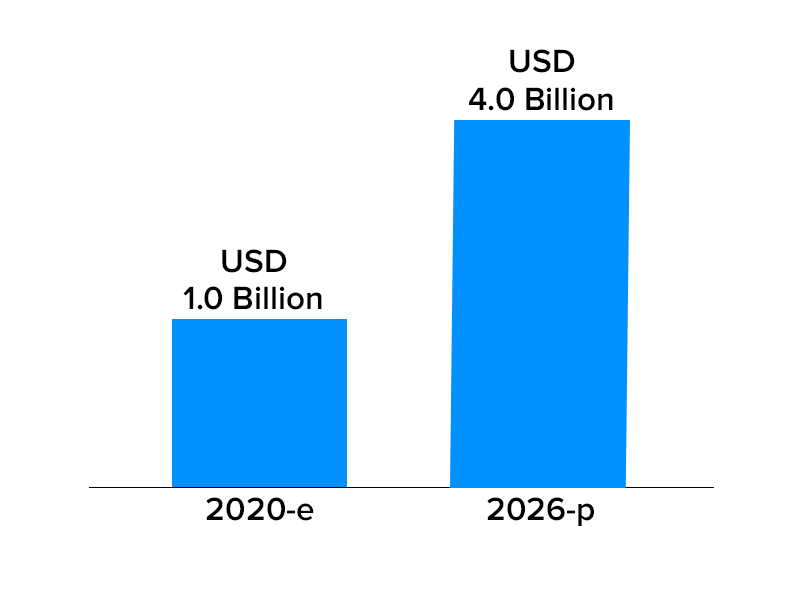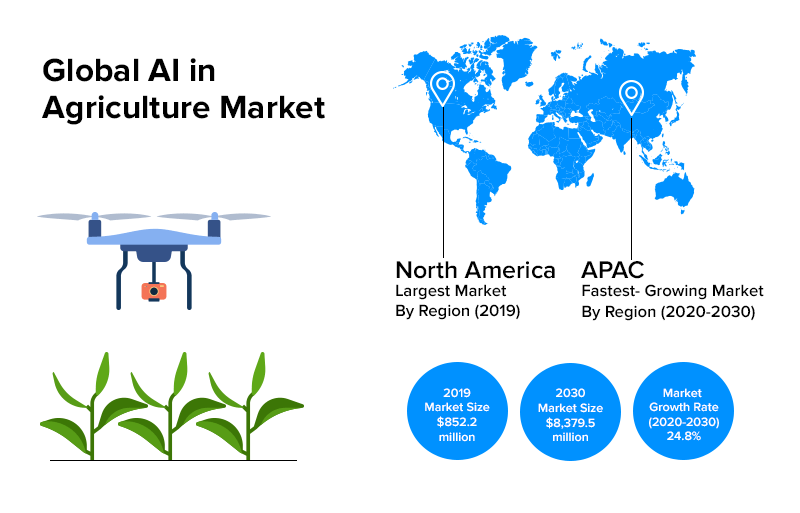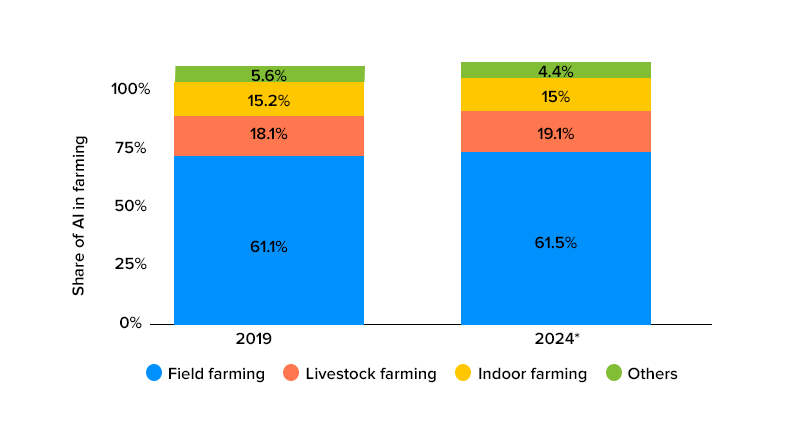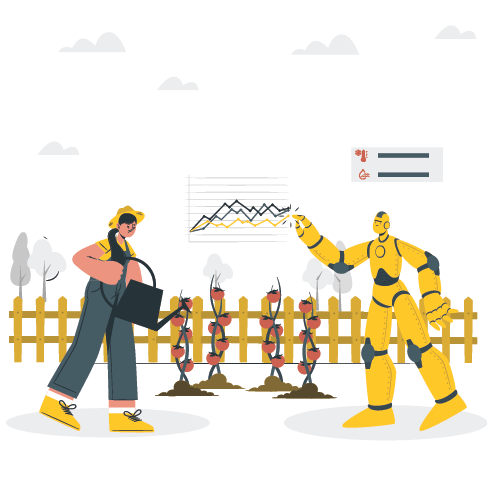AI in agriculture helps farmers deliver efficiency using the data and devices like smart drones, autonomous tractors, soil sensors, and so on.
Agriculture is one of the oldest and the most important practice of growing crops and raising livestock in the world. We humans have come a long way on how we farm and grow new crops with the help of new technologies. The population of the world continues to grow as we speak and in 30 years the global population will reach 9.7 billion according to the UN estimates. So, in order to feed everyone and solve the climate change issues at the same time, we need to produce 50% more food by 2050 on the same land and reduce our greenhouse gas emissions that are caused due to agriculture.
With such goals in mind we need to seek ways to revolutionize our farming techniques and a better way to figure this out is to introduce artificial intelligence in agriculture. AI -based technology in agriculture helps in growing healthier crops, controlling pests, observing the growing conditions, monitoring the soil, organizing data for farmers and helping them with multiple tasks.
AI is used by many companies in the agriculture sector through precision farming and predictive analytics. Let’s look into the Market growth of AI in agriculture through the below statistics:
Market Overview
- According to Markets and Markets, spending on AI technologies and solutions in Agriculture is estimated to grow from $1 billion in 2020 to $4 billion in 2026, attaining a Compound Annual Growth Rate (CAGR) of 25.5% between 2020 and 2026.

- AI in agriculture market size stood at $852.2 million in 2019, and it is expected to reach $8,379.5 million by 2030, exhibiting a CAGR of 24.8% during the forecast period (2020–2030).
- By region, North America generated the highest revenue in AI in the agriculture market but it is predicted that the fastest growing market will be the Asia Pacific.

- Artificial intelligence is deployed in agriculture mainly in field, livestock, and indoor farming in 2019. Field farming is the main farming type where AI is used in agriculture, with a market share of more than 60%.

AI Applications In Agriculture
The adoption rate of artificial intelligence in the agriculture industry has changed the overall outcome of farming efforts, with a majority of startups in agriculture adapting AI-enabled approaches to increase the efficiency of agricultural production. Let’s dive in deep into the future of AI in agriculture.
1. Predicting the weather
Over the years we have experienced a drastic increase in the pollution level and unpredictable climatic conditions. The change in climate has made it difficult for farmers to determine the right time for sowing seeds and that’s where AI comes into the picture. With the help of artificial intelligence it is easy to gain insight into how weather, seasonal sunlight, wind speed, and rain will affect the crop planting cycles. Weather forecasting will help farmers analyze and plan when the seeds should be sown.
Use case: IBM weather forecast sends out alerts in case of weather disruptions and provides integrated solutions to help maximize crop yields, minimize environmental impact and reduce costs.
2. Monitoring soil and crop in real-time
Soil is one of the most important factors that determines the growth and health of any plant. The nutrition of the soil determines the quality of the crop. Due to deforestation, the soil quality deteriorates over time and it becomes very difficult for the farmer to understand what soil will be best for what crop.
Use Case: An AI-based application called Plantix uses image recognition-based technology that helps farmers identify nutrient deficiencies in soil, plant pests and other diseases. With the help of Plantix, farmers can easily figure out which fertilizer to use in order to improve the quality of the harvest. The app also provides tips and solutions for the detected problems.
3. Using drones for data collection
Thanks to AI and machine learning in agriculture that crop yield can be improved through real-time sensor data and visual analytics data from drones. Drones can provide real-time video surveillance that can analyze growth patterns of the crops.
On the other hand, smart sensors can provide data of moisture, fertilizer and natural nutrient levels. That being said, we cannot deny the fact that drones are a reliable tool for capturing data on how specific fertilizers, watering patterns and pesticide treatment methods are improving crop yields.
Use case: PrecisionHawk allows farmers to virtually walk around their fields with the help of drones. Farming operations of all sizes either big or small, are using drones to reduce the time and costs associated with crop data collection.
4. Precision farming
Use of AI in agriculture has resulted in applications that provide farmers with proper guidance regarding water management, crop rotation, timely harvesting, optimum planting, pest attacks, etc. With the help of machine learning algorithms and the images captured by satellites and drones, we can predict weather conditions, nutrition management and analyze crop sustainability.
Precision farming is an approach where data inputs are utilised in precise amounts to achieve maximum crop yields. Farmers with smartphones and AI applications can get a customized plan for their lands. With such IoT and AI driven solutions, farmers can meet the requirements of our current and future world that include – increased food sustainably, growing production and revenues without depleting any of our natural resources.
The market value of precision farming is expected to grow from approximately 5.09 million U.S. dollars in 2018 to 9.53 billion U.S. dollars by 2023.
5. AI powered robots
AI powered companies are developing robots to perform multiple farming tasks. These robots will be trained to control the excessive growth of weeds and to harvest crops. They will also be trained to pick and pack crops. The goal is to automate such manual tasks and accomplish them at a much faster pace with higher volumes when compared to humans.
Use case: Agrobot robots have the ability to operate 24/7 which increases the efficiency, optimizes the cost of precision to weed, hoe, and harvest. The Argobot E-series with advanced AI system not only picks up the crops but it can also identify the ripeness of the crop in the field.
6. AI enabled surveillance systems
AI technology in agriculture enables the usage of satellite images in order to compare them with past data to detect animal or human breaches. This reduces the risk of any domestic or wild animal that can destroy crops. AI algorithms can also detect something as small as an insect, for example- locust, grasshopper, etc. Once an intrusion is detected, alerts are immediately sent to the farmers on their smartphones so that they can take the required precautions.
Use case: Plantix app turns your smartphone into a mobile crop doctor with which you can accurately detect pests and diseases on crops within seconds. Plantix serves as a complete solution for crop production and management.
Benefits of AI in Agriculture
- AI in agriculture is a more efficient way to produce, harvest and sell essential crops.
- Implementing AI-empowered approaches in farming can help farmers respond smartly to climate changes
- AI emphasis on checking defective crops, pest identification further improving crop health and yields.
- With the help of AI, it is impossible for intruders – wild or domestic animals and thieves to ruin your harvest.
- Crop management practices are improved with the help of technology. Farmers can produce higher crop yield with better quality by using fewer resources.
- AI technology reduces the labour challenge and automates manual work, accelerating the food transformation.
Final Say
Technological advancements in agriculture will help the world deal with food production issues for the growing population. The growth in artificial intelligence technology has strengthened agro-based businesses to run more efficiently than ever. If you are looking for an AI app development company for your brilliant idea, this is the time to bring that idea to life.
We also serve across the globe with our AI development services in USA , Europe, and Asia to help our customers and clients achieve their goals.

strategies your digital product..



